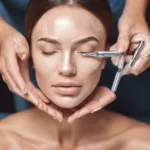27 November 2023
Learn about the benefits, risks, and procedure of dermaplaning, a popular skin treatment that reveals brighter, smoother skin.
Dermaplaning, a minimally invasive procedure, has gained popularity in recent years as a method to achieve smoother, brighter skin. By shaving off the top layers of skin and removing unwanted hair, dermaplaning offers a range of benefits, including reducing the appearance of acne scars and fine lines, exfoliating dull skin, and allowing for deeper absorption of skincare products. In this comprehensive guide, we will delve into the details of dermaplaning, including its key differences from other skin resurfacing treatments, who can benefit from it, and what to expect during and after the procedure.
What is Dermaplaning?
Dermaplaning involves the use of a handheld surgical device called a dermatome to gently shave off thin layers of skin and hair. This method can be performed on specific problem areas or the entire face, depending on individual needs. It is commonly used to reduce the appearance of fine lines, wrinkles, and acne scars. Unlike dermabrasion and microdermabrasion, which use different tools and techniques, dermaplaning offers a deeper exfoliation and can remove more layers of skin and hair.
Benefits of Dermaplaning
Dermaplaning offers a range of benefits, including reducing the appearance of fine lines, acne scars, and pitted skin. It also brightens dull and dry skin, removes unwanted hair, improves skin texture, treats sun-damaged skin, and allows for deeper absorption of skincare products. Additionally, dermaplaning can serve as a preparation step for other skincare treatments or surgical procedures.
Who is Dermaplaning Right For?
Dermaplaning is suitable for almost anyone looking to improve the texture and appearance of their skin. Individuals with sun-damaged skin, signs of skin aging, and certain skin conditions like rosacea can benefit from this treatment. However, it is important to avoid dermaplaning if you have an active acne breakout, cold sores, skin rashes, burns, or moles and skin tags.
What Happens Before, During, and After Dermaplaning?
Before a dermaplaning session, a consultation with a dermatologist or aesthetician is necessary to discuss goals and potential risks. Preparing for the appointment may involve cleansing the face, removing makeup and skincare products, and avoiding certain medications. During the procedure, a numbing cream or anesthesia may be applied to the skin to minimize discomfort. The dermatome is then used to gently remove the top layers of skin. The session can last from a few minutes to an hour. After dermaplaning, skincare products may be applied to enhance penetration, and immediate results are typically visible. Some temporary side effects, such as redness or sensitivity, may occur but usually fade within a few months.
Risks of Dermaplaning
While dermaplaning is generally safe and effective, there are potential risks to consider. These include scarring, nicks and cuts, fever blisters, skin irritation, and thickened skin. However, these risks are relatively rare when the procedure is performed by a trained professional.
Conclusion:
Dermaplaning has become a popular choice for individuals seeking smoother, brighter skin. With its range of benefits and relatively low risks, dermaplaning offers a minimally invasive solution to reduce the appearance of acne scars, fine lines, and dull skin. By understanding the procedure, its benefits, and potential risks, individuals can make informed decisions about whether dermaplaning is the right option for them. It is important to consult with a dermatologist or aesthetician to ensure a safe and effective dermaplaning experience.



